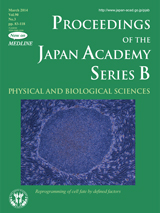About the Cover
Vol. 90 No. 3 (2014)
Induced pluripotent stem (iPS) cell were originally generated from mouse (Takahashi et al., Cell, 2006) and human (Takahashi et al., Cell, 2007) fibroblasts by the retroviral introduction of Oct3/4, Sox2, c-Myc and Klf4 (Figure). The iPS cells are similar to embryonic stem (ES) cells in their morphology, proliferation, gene expression, and most importantly, pluripotency.
The idea of iPS cell generation was conceived through an integration of three important scientific discoveries. The first was nuclear reprogramming. In 1962, Dr. Gurdon discovered this phenomenon by transplanting amphibian somatic cell nuclei into enucleated unfertilized eggs. The second one was factor-mediated cell fate conversion, which was first demonstrated by Dr. Weintraub in 1987. He observed a conversion of mouse fibroblasts into myoblasts by the forced expression of myoblast-specific transcription factors. This suggested the existence of a “master” transcription factor that determines the fate of the cell lineage. The third one was the establishment of ES cells from mice by Dr. Evans in 1981 and from humans by Dr. Thomson in 1998. Further characterizations of the ES cells identified some key molecules which are essential for the maintenance of pluripotency.
Inspired by these previous studies, Dr. Yamanaka and colleagues identified four transcription factors that could induce pluripotency in somatic cells by their enforced expression, and successfully consolidated effective reprogramming methods in mammals. These achievements clearly demonstrate the marvelous plasticity of cell fate, even in fully differentiated adult cells, and have opened the door to scientists to demonstrate direct conversion of a certain somatic cell type to others, such as endocrine cells, neurons and cardiac myocytes by the ectopic expression of defined factors.
Moreover, the iPS cell technology will contribute to not only a further understanding of cellular regulation and developmental biology, but also to regenerative medicine, disease modeling, drug screening, toxicity assessment and proof-of-concept studies in drug development.
Head of Director's Office / Special-Appointment Associate Professor
Center for iPS Cell Research and Application (CiRA), Kyoto University




